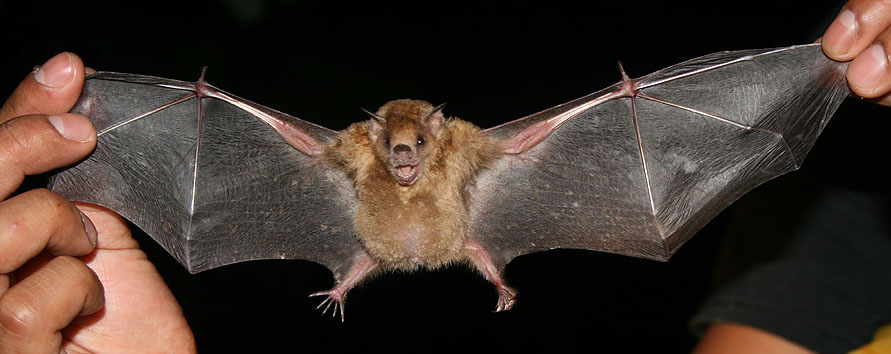Every winter brings with it lines
of people crowding to get that season’s influenza (flu) vaccine,
a collection of several inactivated or recombinant flu viruses. The vaccine
provides protection against several different strains of flu, and each year
brings with it slightly different strains to avoid. Back in 2009, a pandemic of
H1N1, a new strain of flu deriving from bird, swine, and human flu viruses,
swept the United States and Mexico, causing over 14,000
confirmed deaths worldwide. Now, we must be ever-vigilant for new influenza
viruses that could potentially prove deadly.
In a recent
article by Moreira et
al. (October 24, 2016), a team uncovered two new influenza A-like bat
viruses—in other words, some bats may have a new form of flu. (While influenza
A viruses don’t often infect humans, they can cause severe
disease in birds.) The researchers also succeeded in propagating this viral
infection, meaning that they successfully identified the genes necessary to encode
these fully functional viruses. The article aimed to answer a simple question:
could these viruses, in theory, infect human populations? To investigate this
question, the researchers introduced the viral genes into another type of
virus, a vesicular stomatitis virus (VSV), which they could then inject into 32
different types of cells. As a second experiment, they also used a new
biological technique, the reverse genetics method, to engineer the viruses’
most important proteins from their genetic information, and they injected the
newly engineered proteins into these 32 cell types. The types of cells tested varied
greatly, including cells from humans, monkeys, bats, pigs, and birds. Both
engineered and VSV-injected viruses most easily infected a particular line of
canine cells, Madin-Darby canine kidney type II (MDCK II) cells. Using the
results of these infections, the researchers were able to learn more about how
these newly discovered viruses function.
 |
| Sturnira lilium (above) and Artibeus planirostris (below), the two bat species in which these new viruses were discovered. |
The new viruses are called HL18NL11
and HL17NL10, based on the proteins that make up these viruses. Viruses are
typically classified by the structures of their H (hemagglutinin) and N (neuraminidase)
proteins. Since the proteins found in these specific viruses don’t carry out
the same functions as typical H and N proteins, they are referred to as HL and
NL, “hemagglutinin-like” and “neuraminidase-like”, respectively. Both HL17 and
HL18 proteins resemble the structure of the H proteins found in conventional
influenza A viruses. However, the paper did not investigate the NL proteins
very closely, since the function of NL proteins is not well understood.
Although the newly discovered
viruses are structurally similar to influenza A viruses, the new viruses have a
different mode of transmission from influenza A. Instead of entering the cell by
the apical surface, the surface of the cell facing the external environment, they
enter the cell by the basolateral surface, the surface that touches neighboring
cells—in other words, the cellular equivalent of sneaking in the back door. However,
once inside the cell, the viruses are transported to the apical surface to
replicate, and the replication and release processes of the new viruses are
very similar to those of classic influenza A viruses. Because of their
resemblance to these viruses that so often cause disease in birds, the new
viruses were tested on cell lines from many different species to see whether
they could infect different types of cells.
 |
Viruses enter by the basal surface of the cells (the
surface facing other cells), and new viruses are released from the apical
surface (the cell surface facing the external environment).
|
In the end, most cell lines were
resistant to both the original viral genes and the genes injected into VSV
(vesicular stomatitis virus, described above). However, they replicated very
well in a few cell lines, especially the Madin-Darby canine kidney type II
(MDCK II) cell line. More importantly, the viruses were able to infect two
human cell lines, which indicates the potential for human infection.
So what does this result mean for
us? Most likely, we will not have an HL17NL10 or HL18NL11 outbreak anytime
soon. Nevertheless, this research was able to investigate a potential threat.
Additionally, the research highlighted the use of an important virological
research strategy, the reverse genetic system, for characterizing viruses that
won’t grow in lab. Using reverse genetics, the researchers were able to rebuild
the viruses using their knowledge of the viral genetic material. In the future,
the research team could use this strategy to identify the function of the NL
protein in this virus. They could also try injecting both their
reverse-genetics-created viral sequences and the VSV-injected viruses into live
bats. This would allow them to see if the reverse genetic strategy showed a
similar pathology to the original virus, and they could compare the
pathogenicity and infectivity of VSV-combined viruses, reverse-genetics-created
viruses, and wild-type viruses (the version of the virus that the bats were simply
acquiring in the wild). Such experiments would also allow the research team to evaluate
the implications of their current findings a little more closely.
Sources
Note: All sources and pictures are also hyperlinked in text.
- Moreira, É. A., Locher, S., Kolesnikova, L., Bolte, H., Aydillo, T., García-Sastre, A., ... & Zimmer, G. (2016). Synthetically derived bat influenza A-like viruses reveal a cell type-but not species-specific tropism. Proceedings of the National Academy of Sciences, 201608821.
- Key Facts About Seasonal Flu Vaccine. (2016). Retrieved November 11, 2016, from http://www.cdc.gov/flu/protect/keyfacts.htm
- In New Theory, Swine Flu Started in Asia, Not Mexico - The ... (n.d.). Retrieved November 11, 2016, from http://www.nytimes.com/2009/06/24/health/24flu.html
- Main developments in the past 72 hours. (n.d.). Retrieved November 11, 2016, from http://ecdc.europa.eu/en/healthtopics/Documents/100118_Influenza_AH1N1_Situation_Report_0900hrs.pdf
- Avian influenza. (n.d.). Retrieved November 11, 2016, from http://www.who.int/mediacentre/factsheets/avian_influenza/en/
Photo sources:
- https://upload.wikimedia.org/wikipedia/commons/0/0a/Sturnira_lilium_lostuxtlas2008.jpg
- https://blogger.googleusercontent.com/img/b/R29vZ2xl/AVvXsEhZYOtDQfA8HbTHStxBiEs36EcGIcSDIuOp4Kx51d-Ea9cKGFFk4iCfQNQJW0xnw4DfPK4StsspXWnOaoYIhBsGoRWu3MQ3YvZikFo7hW17ypYe2ECMJrgXPEwz1Zg76YTHQXIux5wPP-w/s1600/IMG_0620.jpg

No comments:
Post a Comment